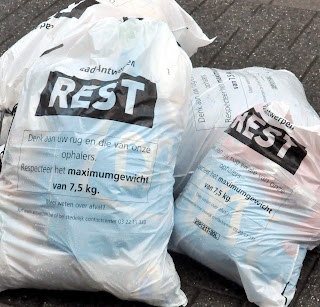The
production and recycling of plastic is heavy on the environment. I am not
talking about plastic in general but single-use plastic. Plastic is a very
useful product for all sorts of applications.
But
it is not just the production and recycling that is heavy on the environment. I
just learnt that plastic waste releases greenhouse gases whilst decomposing. So
those of you who think plastic and climate change are separate things are
wrong!
And
that is just about the greenhouse gas effect, let’s not forget the horrible
sights of waste on beaches and all animals suffering from plastic that has
ended up in their habitats.
The
good news is that reducing our consumption of plastic (especially single use) is
something we can all do, and I am about to prove that to you.
You
may remember one of my first blogposts, a snapshot of all our household waste
that I had measured in September 2017.
Well,
I did it again. I held on to all of our waste for an entire month. I wanted to
measure the impact of our efforts. We haven’t finished yet. There is still so
much more to do, but I wanted to know where we stand at this moment.
Again,
I didn’t keep all waste. For instance, I didn’t hold on to food leftovers,
Q-tips, kitchen towel, tissues and well… toilet paper.
Furthermore,
this is just a snapshot, rather than an average. Different seasons produce
different waste and sometimes you go through unusual circumstances such as exam
periods, lots of work in the office, preparing for holidays and renovations.
These periods can come with more waste, just because, for instance, buying
ready meals is more convenient than having to cook for yourself!
While
I was collecting waste and saw this amount of plastic growing every day, I didn’t
expect the impact of our efforts to be as big as they were.
If
you want to know what exactly we did and you don’t want to read all the
blogposts again, there is a bullet point list of things you can do at the end
of this blogpost.
OK,
here we go:
2017 kg/month
|
2019 kg/month
|
Difference in percentage
|
|
Cardboard and paper
|
9.28
|
2.2
|
-76.29
|
of which unsolicited mail
|
3.1
|
0
|
-100.00
|
plastic
|
3.7
|
0.8
|
-78.38
|
food packaging
|
1.6
|
0.5
|
-68.75
|
bottles
|
2.1
|
0
|
-100.00
|
drink cartons
|
0.7
|
0.39
|
-44.29
|
Cans
|
2.8
|
0.09
|
-96.79
|
coffee pods
|
0.34
|
0
|
-100.00
|
Other
|
0.3
|
0.5
|
66.67
|
Total
|
17.12
|
3.98
|
-76.75
|
This
time, all of our unrecyclable waste of one month fitted into one (1!) 45 gram bin
bag. That is 540 grams/year (12 bin bags) instead of 2,340 grams (52 bin
bags).
So
this is the result of what exactly?
·
Food leftovers are kept out of the bin and
are being composted;
·
We have tackled and will keep tackling all
unsolicited mail;
· We don’t buy bottled water anymore. We
filter tap water with carbon sticks and we bought a soda stream for soda water;
·
We don’t buy fruit and vegetables in
plastic anymore; meat and fish remain a challenge;
· We squeeze our own fruit juice and fill our
own glass bottles at the milk truck every week. In January the truck didn’t
show up. That’s why there were still some drink cartons in the statistics. I am
looking for a second milk provider;
·
We stopped using coffee pods, at home and
in the office (just me);
· We don’t buy beer cans anymore. We buy beer
in glass bottles and take the empties back to the shop.
The
two cans in the January statistics are cans I found on my doorstep. They were
in fact not ours. I also used 2 cans of corn, which I normally buy in a glass
jar, but they were not available when I needed them. Well, I say “needed”. We
mostly only think we “need” stuff. Very often this is actually just “want now”. I could have made
something else instead.
So
step by step, over a period of 16 months, we have managed to reduce our waste
by more than 75%.
And
there is still so much more that we can do. I am being fed ideas by people who
read my blog - thanks for that! You know who you are.
If
you want to find out what these are: stay tuned!







